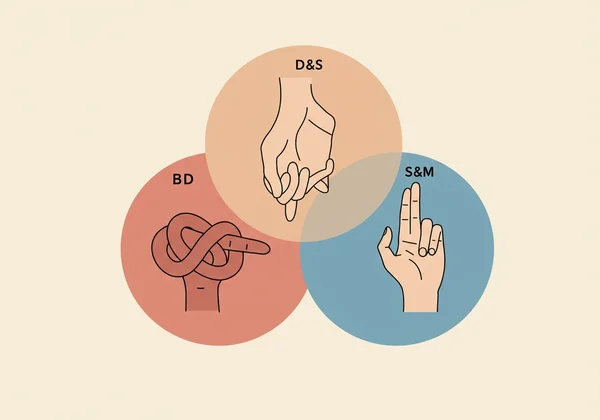What is BDSM? A Beginner's Guide to Kink Exploration & BDSM Test
For many, the term BDSM conjures sensationalized images or generates a swirl of curiosity and confusion. If you've ever felt a pull toward something different, an unexplored aspect of your desires, you are not alone. This guide is your starting point—a safe, non-judgmental space to demystify BDSM, answer your questions like What are kinks?, and prepare you for a BDSM test to build a foundation for healthy exploration. Your journey to discover the true self on the inside begins with understanding, and we're here to help you take that first step.
The path to self-discovery can be thrilling. It often starts with a simple question about your own preferences and boundaries. If you're ready to begin that reflection, you can start your journey with a tool designed by psychologists and experienced practitioners to help you explore your inner world in a private, secure environment.

BDSM Definition: Understanding the Fundamentals
At its core, BDSM is a wide-ranging term for certain types of erotic behavior and relational dynamics. It's an umbrella that covers a vast spectrum of interests, all centered on consensual power exchange, sensation play, and imaginative role-playing. Understanding the BDSM definition is the first step in replacing uncertainty with knowledge. It’s about communication, trust, and exploring fantasies between consenting adults.
Breaking Down the Acronym: B.D.S.M. Unpacked
The term BDSM itself is an acronym, representing four interconnected but distinct categories. These elements can exist independently or be combined in countless ways.
-
B&D (Bondage & Discipline): This involves the use of physical restraints, such as ropes, cuffs, or ties, to heighten sensation and create a sense of vulnerability or powerlessness. Discipline refers to the use of rules and consequences within a consensual dynamic.
-
D&S (Dominance & Submission): This is a psychological and relational dynamic where one person consensually takes a dominant role and another takes a submissive role. It’s about the consensual exchange of power and control, often building deep trust and emotional connection.
-
S&M (Sadism & Masochism): This refers to the giving (sadism) and receiving (masochism) of consensual pain for pleasure. This can range from light spanking to more intense forms of sensation play, where the experience triggers a release of endorphins and creates a powerful psychological release.

Kink vs. BDSM: Understanding the Nuances
You might hear the words "kink" and "BDSM" used interchangeably, but there's a subtle difference. "Kink" is a broad, inclusive term for any unconventional sexual preference or fantasy. It's the large umbrella under which many things, including specific fetishes and practices, can fall.
BDSM is a major category of kink that specifically involves the power dynamics and activities outlined above. Think of it this way: all BDSM is a form of kink, but not all kinks are BDSM. Understanding this distinction helps in navigating conversations and your own self-exploration with more clarity. To get a better sense of where your interests might lie, taking a comprehensive BDSM roles test can be an insightful first step.
Core Components: Pillars of Safe BDSM Exploration
Beyond the acronyms and activities, BDSM is built on a strong ethical foundation. This framework is what separates consensual play from harm and ensures that all participants feel respected, secure, and empowered throughout the experience. Committing to safe BDSM exploration is non-negotiable.
The Absolute Core: Safe, Sane, and Consensual (SSC)
SSC is the golden rule of the BDSM community. It's a philosophy that must guide every interaction.
-
Safe: All activities should be approached with an awareness of the physical and psychological risks involved. This means using proper techniques, understanding anatomy (for bondage), and having safety measures like release tools or a way to stop immediately.
-
Sane: All participants must be of sound mind and able to consent clearly. This means being sober, emotionally stable, and fully aware of the decisions they are making. It's about responsible engagement.
-
Consensual: This is the most crucial element. Every single act must be freely and enthusiastically agreed upon by everyone involved. Consent can be withdrawn at any time, for any reason, and this must be respected without question.

Power Dynamics: Dominance, Submission, and Fluidity
At the heart of many BDSM interactions is the consensual exchange of power. This isn't about real-world control, but a negotiated dynamic that can be deeply fulfilling.
- Dominant (Dom): The person who takes the lead, sets the rules, and is in control of the scene.
- Submissive (Sub): The person who relinquishes control to the Dominant, finding pleasure in service, obedience, or vulnerability.
- Switch: A person who enjoys playing both Dominant and submissive roles, depending on their partner or mood.
Many practitioners find that these roles, far from being rigid identities, offer profound avenues for self-expression and connection. They are fluid expressions of desire, and many people find that their preferences shift over time. If you're wondering where you might fit on this spectrum, a well-designed dominant and submissive quiz can offer personal insights.
Common Play Styles & Activities for Beginners
For those just starting, the world of BDSM can seem vast. Some common entry points for beginners are centered on lighter forms of play that help build trust and communication. This can include things like sensory deprivation using a blindfold, light impact play like spanking, or simple role-playing scenarios. The key is to start slow, communicate openly, and discover what feels right for you and your partner.
Dispelling Myths: What BDSM Isn't
Unfortunately, mainstream media and lack of education have created harmful myths about BDSM. Confronting these misconceptions is essential for anyone curious about this world, whether for themselves or a partner. Our goal is to create a judgment-free zone, and that starts with truth.
Myth: BDSM is Abuse or Non-Consensual
This is the most damaging myth. The bedrock of BDSM is enthusiastic consent. Unlike abuse, which is about violating boundaries, BDSM is about meticulously negotiating and respecting them. The use of safewords and constant communication ensures everyone remains in control of their experience. Any activity without clear, ongoing consent is not BDSM; it is assault.
Myth: BDSM is Only About Sex
While BDSM can be highly erotic and often includes sexual activity, it is not solely about sex. For many practitioners, the most profound aspects are psychological and emotional. The deep trust, vulnerability, intimacy, and mental focus involved in a power exchange dynamic can create connections that transcend the purely physical. Many BDSM relationships and scenes have no sexual component at all.
Myth: It's for "Broken" or "Deviant" People
This myth stems from a lack of understanding and a tendency to pathologize what is different. People from all walks of life, professions, and psychological profiles enjoy BDSM. It is a valid and healthy expression of human sexuality and relationship dynamics for millions of people worldwide. Curiosity about BDSM doesn't indicate anything is wrong with you; it indicates you have a rich inner world worth exploring. Taking our BDSM quiz is a step towards embracing that curiosity in a healthy way.
Your Journey into BDSM Understanding Begins
Navigating the landscape of BDSM is a personal journey of self-discovery. It’s about learning your desires, understanding your boundaries, and finding new ways to connect with yourself and others. We've demystified the definition, highlighted the pillars of safety, and debunked harmful myths. The next step is yours to take.
This guide is just the beginning. The most exciting part of this exploration is learning about your unique self. Taking a BDSM test can be an incredibly insightful way to look inward. If you are ready to look inward, we invite you to take our free BDSM test. It's a confidential, expert-designed tool that can help you decode your inclinations and provide a personalized starting point for your journey.

Frequently Asked Questions About BDSM
What are kinks?
Kinks are any sexual interests, fantasies, or practices that fall outside of what is considered conventional. This is a very broad term that can include anything from a foot fetish to an interest in role-playing or specific materials like leather or latex. BDSM is a large and popular subcategory of kink.
How to safely explore BDSM?
Safe exploration hinges on the principles of SSC (Safe, Sane, Consensual). This means educating yourself, communicating openly and honestly with partners, negotiating clear boundaries and limits beforehand, and establishing a safeword that will immediately stop all activity. Start slow and never feel pressured to do anything you're not 100% enthusiastic about.
What does 'safe, sane, and consensual' mean?
It is the ethical foundation of BDSM. "Safe" refers to taking precautions to minimize physical and emotional risk. "Sane" means all participants are of sound mind and able to make rational decisions. "Consensual" means everyone involved has given clear, enthusiastic, and ongoing permission for every activity.
Am I dominant or submissive?
This is a question of personal inclination, and the answer can be complex and fluid. Some people feel a clear pull toward taking control (dominant), while others find deep satisfaction in relinquishing it (submissive). Many people are "switches," enjoying both roles. The best way to explore this is through self-reflection, and tools like a what is my BDSM role quiz can provide valuable insights to start that process.